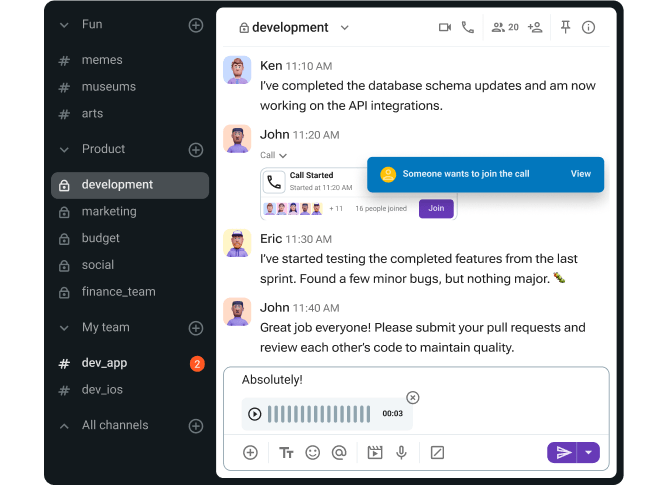À primeira vista, o processo de comunicação parece bastante simples: você diz algo a alguém, a pessoa entende o que você quer dizer e responde com uma reação apropriada.
Mas e quanto a todas aquelas interpretações equivocadas, sinais perdidos ou momentos em que sua intenção passa completamente despercebida?
Esses problemas acontecem porque o processo de comunicação está em constante mutação e depende de 8 fatores interligados.
Neste artigo, estabeleceremos as bases teóricas da comunicação eficaz e exploraremos como aplicá-las para uma comunicação mais eficaz no trabalho.
Também ouviremos especialistas que compartilharão algumas de suas dicas testadas e comprovadas para melhorar o processo de comunicação e eliminar falhas de comunicação.
Esperamos que essas dicas ajudem você a resolver os principais problemas de comunicação da sua equipe, evitar que a situação se torne caótica e minimizar tarefas repetitivas.
Pronto? Vamos começar!

O que é um processo de comunicação?
O processo de comunicação é uma sequência de ações necessárias para uma comunicação eficaz. Essas ações garantem a transmissão correta do significado entre pelo menos dois participantes, ajudando-os a se entenderem sem dificuldade.
No entanto, às vezes as coisas não são tão simples quanto parecem.
Na realidade, uma comunicação eficaz requer atenção cuidadosa aos oito elementos interconectados que a compõem. Se seguido corretamente, o processo de comunicação pode garantir que a mensagem pretendida seja transmitida e compreendida sem mal-entendidos ou confusão.
Vamos analisar o processo de comunicação e seus elementos formativos para melhor compreendê-lo.
Quais são os oito elementos do processo de comunicação?
No livro The Process of Communication: An Introduction to Theory and Practice, o teórico da comunicação David K. Berlo destaca que a comunicação, como outros processos, é dinâmica e está em constante evolução.
Essencialmente, isso significa que o assunto muda dependendo de com quem você está falando, assim como o tom de voz e a linguagem corporal. No entanto, certos elementos são universais em todas as interações.
Os oito elementos do processo de comunicação são:
- Fonte (ou Remetente) — a pessoa que inicia a conversa
- Mensagem — o propósito da comunicação iniciada
- Canal — o meio pelo qual a mensagem viaja da fonte ao receptor
- Receptor — a pessoa ou grupo de pessoas que recebe e interpreta a mensagem
- Feedback — a resposta do receptor à mensagem
- Ambiente — os contextos mental e físico em que nos comunicamos
- Contexto — o cenário, o ambiente e as expectativas dos participantes da conversa
- Interferência (ruído) — qualquer coisa que distorça ou modifique o significado pretendido de uma mensagem
Agora, vamos analisar mais detalhadamente como todos esses elementos interagem para criar o processo de comunicação.
Entender isso ajudará você a dividir a comunicação em etapas para que possa identificar cada uma delas que você ou sua equipe possam precisar aprimorar.
Como funciona o processo de comunicação?
O processo de comunicação consiste em cinco etapas. As etapas básicas de qualquer conversa são:
- Formação de ideias
- Codificação de mensagem
- Transmissão de mensagens
- Decodificação de mensagens
- Comentários (Feedback)
A divisão dessas fases do ciclo de comunicação o ajudará a compreender melhor seu papel na conversa e a melhorar suas habilidades de comunicação.
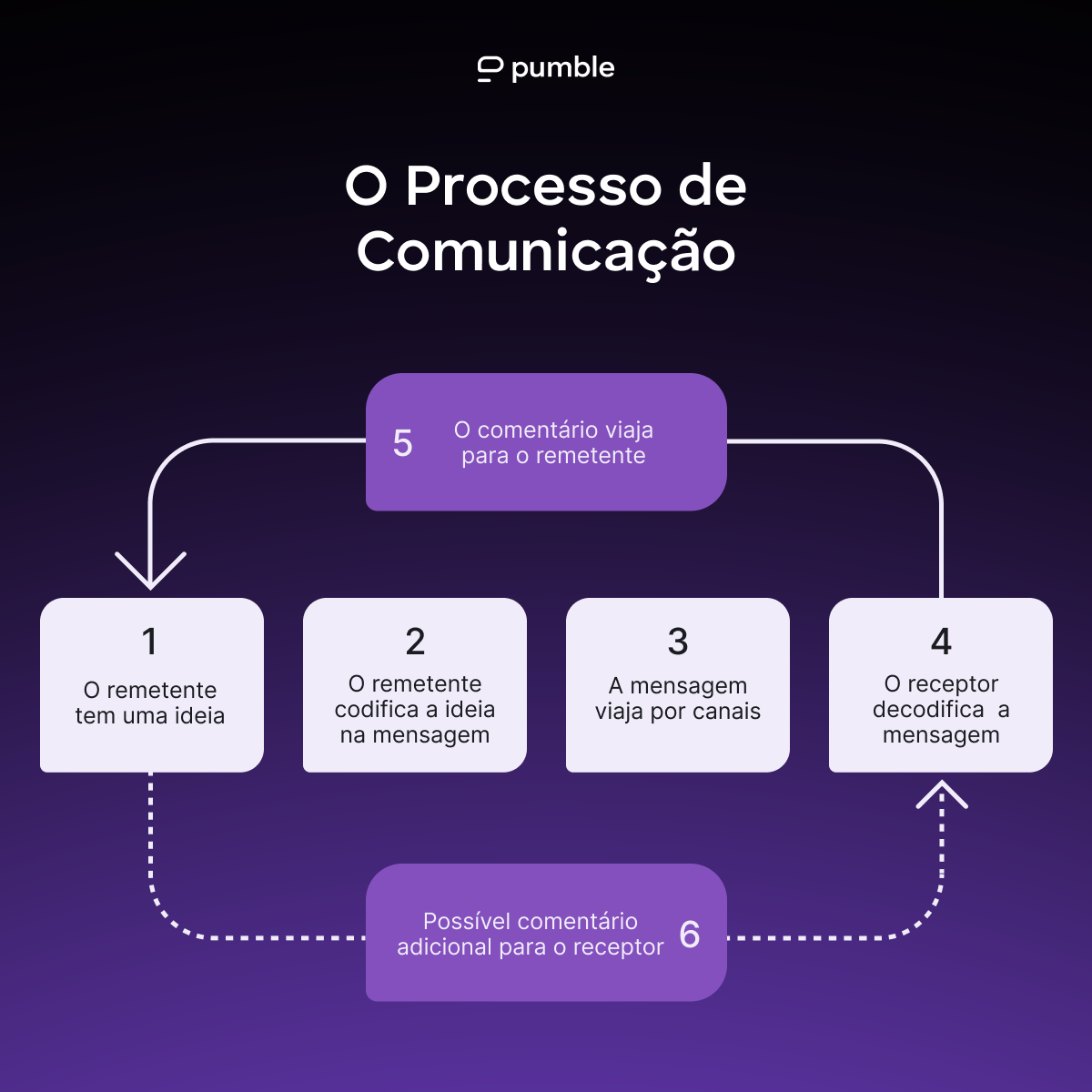
Etapa 1: A fonte ou remetente tem uma ideia (Formação de ideias)
A comunicação começa com a fonte, ou remetente da mensagem.
Vários fatores podem influenciar a mensagem que você deseja transmitir. Antes de dizer ou escrever qualquer coisa, certifique-se de considerar:
- Seu humor e o do seu interlocutor
- Seus respectivos cargos na empresa
- Suas possíveis diferenças culturais
A fonte deve sempre considerar como o receptor ou o público responderá à mensagem.
Uma das habilidades mais valiosas de um comunicador eficaz é a capacidade de adaptar sua mensagem para gerar uma resposta positiva.
Etapa 2: A fonte codifica a ideia em uma mensagem (Codificação)
A codificação envolve transformar uma ideia em gestos e palavras que transmitam significado.
No entanto, pessoas diferentes associam significados diferentes às mesmas palavras, o que pode levar a mal-entendidos.
De acordo com Guffey e Loewy em Business Communication: Process & Product, a falta de comunicação que surge de significados incompatíveis é chamada de bypass e é um dos erros mais comuns na comunicação profissional.
Para evitar essas complicações, use palavras Palavras comuns e fáceis de entender são usadas com a maior frequência possível. Seu objetivo como fonte é estabelecer um significado claro da mensagem principal com seu interlocutor.
No entanto, mesmo que vocês concordem com o significado, compartilhar o mesmo idioma com alguém não significa que vocês compartilham a mesma cultura empresarial.
Vejamos como o idioma e a cultura podem entrar em conflito em uma conversa no Pumble um aplicativo de comunicação em equipe.
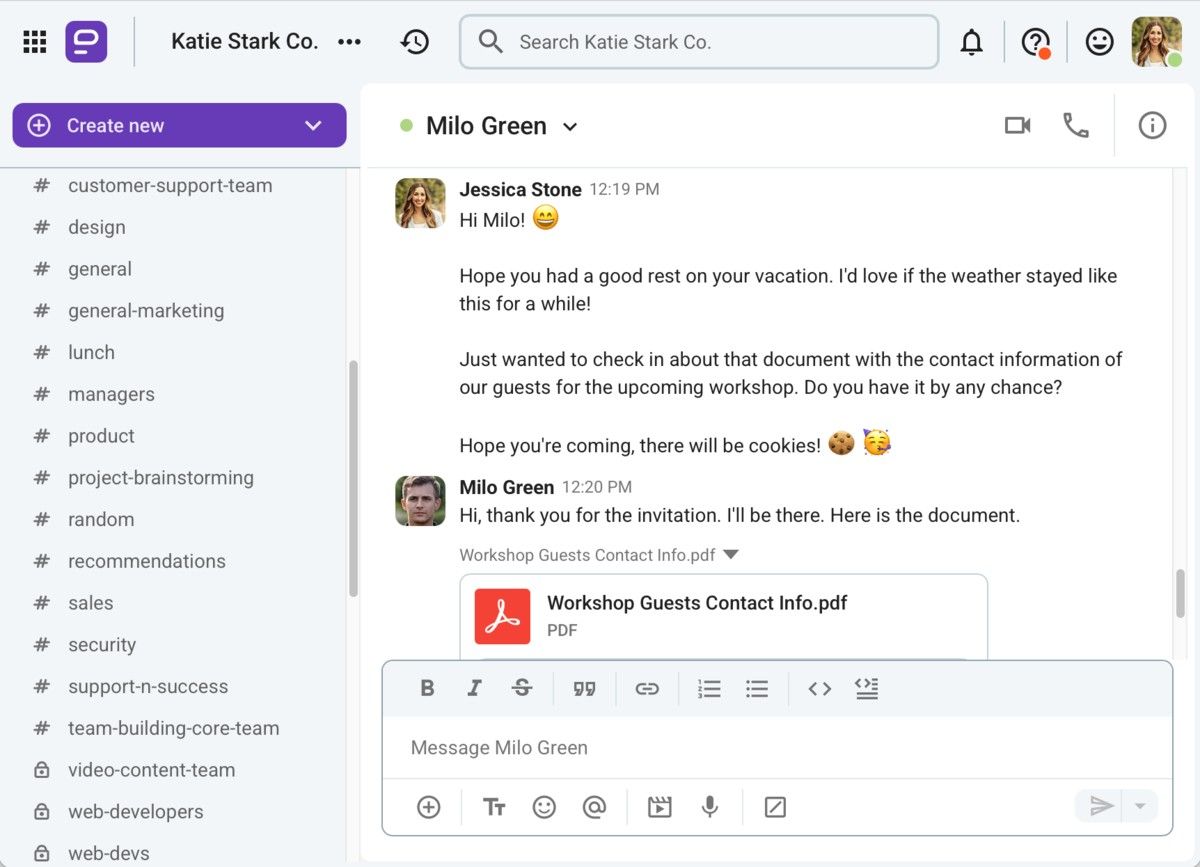
Jessica enviou uma mensagem para Milo, a nova administradora do escritório que acabou de se mudar da Brasil para Portugal. Jessica começa uma conversa casual antes de se aprofundar no objetivo de sua mensagem.
Embora este seja considerado um comportamento educado no Brasil, pode irritar as pessoas em países onde é costume ir direto ao ponto sem se desviar do assunto.
Além disso, Jessica usa os termos “férias” e “biscoitos”. Embora isso não incomode Milo, no Reino Unido é comum ouvir “feriado” ou “biscoitos”.
Por fim, a resposta de Milo é breve e não aborda tópicos fora do trabalho. Isso pode soar frio para Jessica, que está claramente acostumada a outros tipos de interação.
🎓 Dica profissional do Pumble
Para saber como outras diferenças, como cultura, idioma, regras e normas, moldam nossa comunicação, confira nossa postagem no blog:
Passo 3: A mensagem é transmitida através de um canal de comunicação (Transmissão)
Durante o ciclo de comunicação, é necessário encontrar a melhor maneira de transmitir fisicamente a mensagem ao destinatário. O meio de transmissão é o canal de comunicação. Podemos compartilhar mensagens por meio de diversos canais, desde ligações e fotos até e-mails ou aplicativos de mensagens comerciais.
A escolha de um canal de comunicação eficaz pode influenciar significativamente a interpretação do destinatário de mensagens verbais e não verbais.
No exemplo a seguir, Emily compartilha o relatório anual de desempenho com seus colegas. O tom do relatório, o layout e o design do documento podem influenciar a forma como os colegas recebem a mensagem.
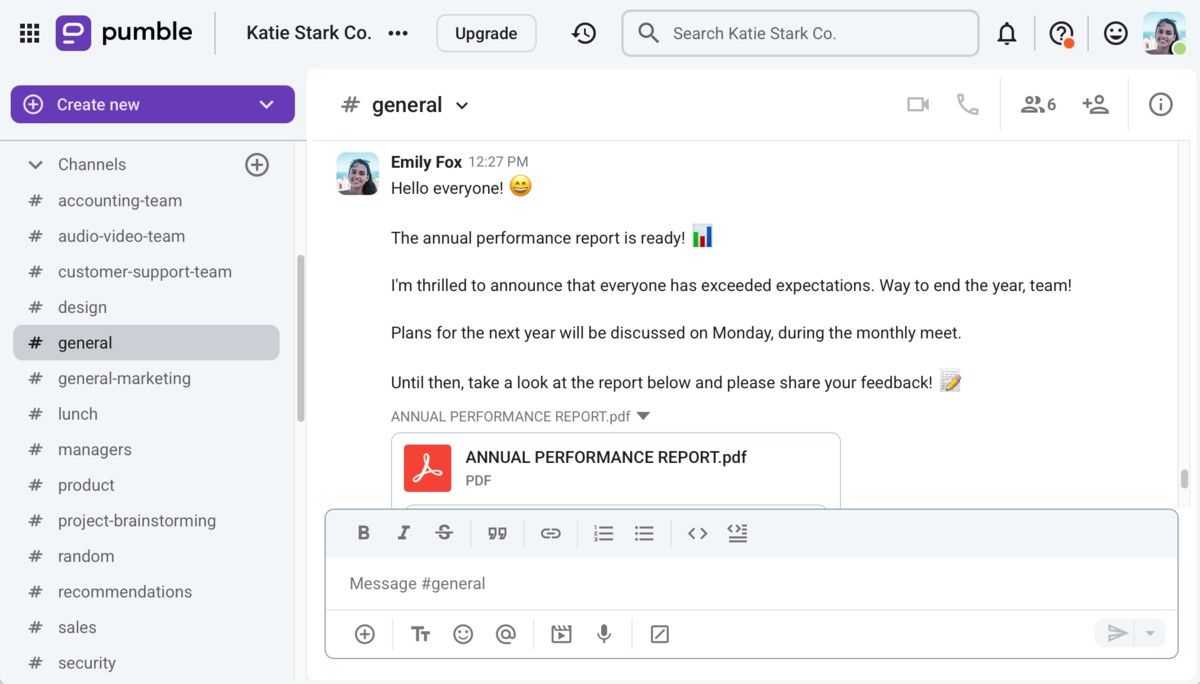
Compartilhe arquivos com segurança pelo Pumble
É claro que antes de escolher o canal mais eficaz, a fonte deve considerar o ruído e como ele pode interferir no processo de comunicação.
Aqui está um exemplo de ruído e como ele pode interromper a comunicação:
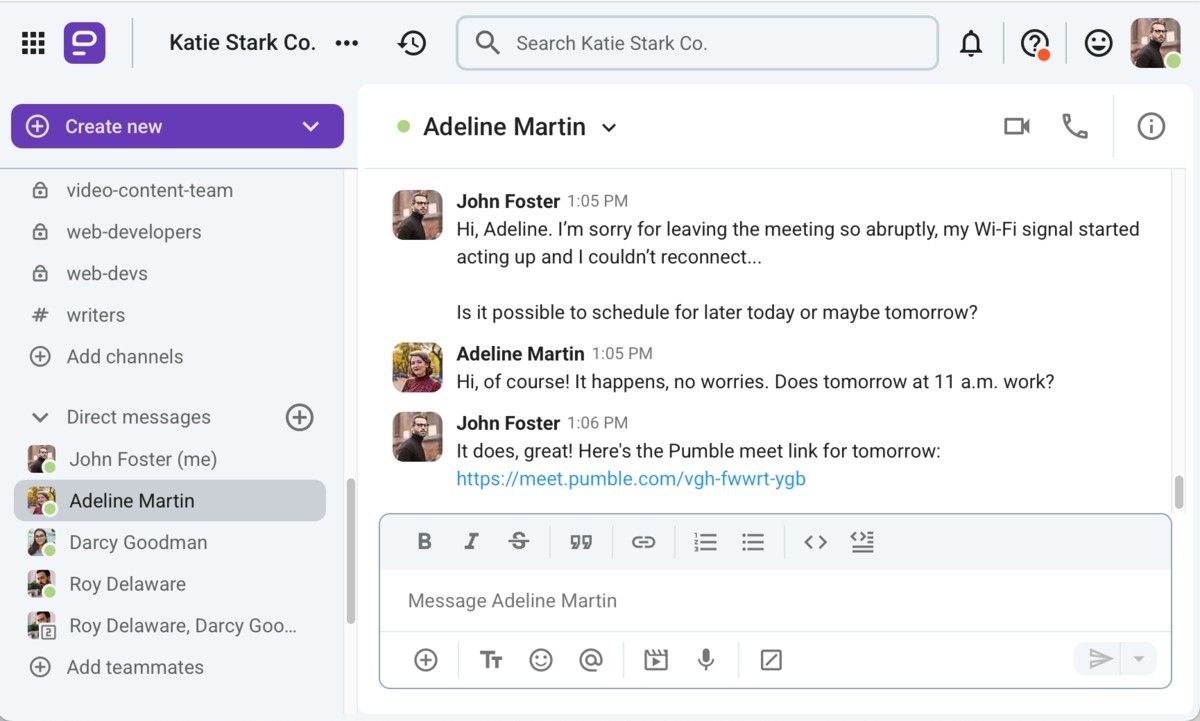
A interferência pode se manifestar de diversas formas, desde erros de ortografia em e-mails comerciais até uma conexão ruim durante uma videochamada virtual.
No entanto, escolher um horário inadequado para enviar um e-mail ou agendar uma reunião de equipe para uma simples atualização também é considerado interferência. É importante ter isso em mente ao usar ferramentas digitais para comunicação interna.
Etapa 4: O receptor decodifica a mensagem (Decodificação)
A decodificação ocorre quando o receptor analisa a mensagem e transforma seus símbolos para descobrir seu significado.
A comunicação bem-sucedida só é alcançada quando o receptor entende o que a fonte pretendia dizer.
Como não há duas pessoas que compartilhem as mesmas experiências e conhecimentos, e como inúmeras barreiras de comunicação podem dificultar a comunicação, a decodificação pode facilmente se tornar um processo difícil.
Fatores internos, como desatenção ao falar e preconceitos, podem causar problemas de decodificação. Fatores externos, como um ambiente barulhento ou problemas técnicos, também podem causar mal-entendidos ou agravar os já existentes.
Comunique-se sem problemas técnicos no Pumble
No entanto, barreiras semânticas também podem causar sérios problemas de comunicação. Vamos analisar o seguinte anúncio como exemplo:
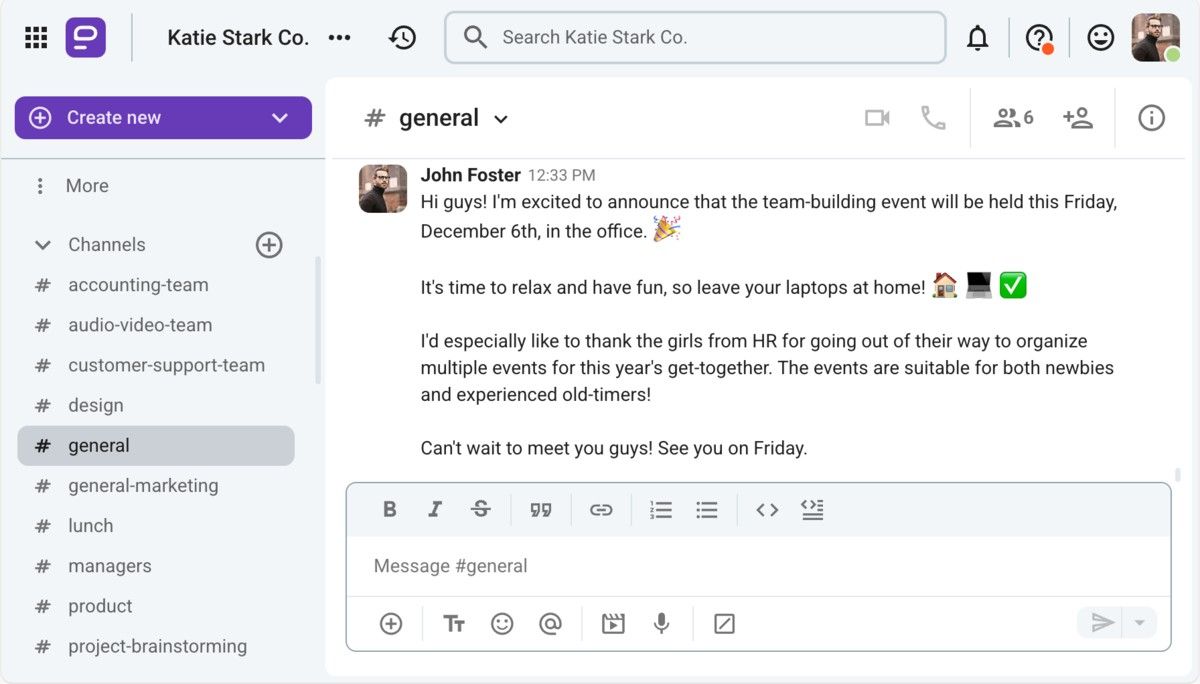
John publicou Ele fez o que considerou um anúncio empolgante sobre um evento da empresa. Embora suas intenções pudessem ter sido boas, suas palavras definitivamente não foram suficientes.
Sua escolha de se referir aos novos funcionários como "novatos", às empregadoras como "garotas" e aos funcionários experientes como "veteranos" tem o potencial de ofender uma parcela da força de trabalho.
Portanto, essa escolha de palavras pode provocar reações fortes que impedem os funcionários de se concentrarem na mensagem geral.
Etapa 5: O comentário chega à fonte
O comentário é a espinha dorsal da comunicação e abrange as respostas verbais e não verbais do interlocutor. Esses sinais permitem que a fonte saiba como alguém percebeu e compreendeu a mensagem.
Por exemplo, quando um colega de trabalho pergunta: "Como foi seu dia?", você pode responder: "Bem, obrigado. E o seu?". Ou, se você teve um dia particularmente cansativo, pode simplesmente sorrir e dar de ombros.
Em aplicativos de comunicação em equipe, você pode enviar uma mensagem, postar um comentário ou usar um emoji para mostrar como se sente.
De qualquer forma, é importante:
- Planejar sua apresentação
- Cronometrar adequadamente
- Dar à outra pessoa tempo suficiente para organizar seus pensamentos
Como todos compartilham diferentes níveis de feedback, também é uma boa ideia incentivá-lo no ambiente de trabalho. Você pode fazer isso com perguntas como "Está tudo claro?" ou "Precisa de esclarecimento sobre algo que mencionei?"
🎓 Dica profissional do Pumble
No contexto do processo de comunicação, feedback se refere à resposta imediata de uma pessoa, mas você provavelmente já viu o tipo de feedback que se refere ao trabalho ou comportamento de alguém. Para saber mais sobre como dar e solicitar esse tipo de feedback no trabalho, consulte:
Dicas para melhorar o processo de comunicação
Agora que estamos familiarizados com os 8 elementos e 5 etapas do processo de comunicação, vamos nos concentrar em aprender como garantir os melhores resultados possíveis.
Dica 1: Tenha cuidado para não esquecer
Bypassing é um fenômeno que acontece quando a fonte e o receptor atribuem dois significados completamente diferentes a uma única palavra ou frase.
Por exemplo, se você acabou de conseguir seu primeiro emprego depois de se formar na faculdade, ver a “cadência da reunião” mencionada em uma mensagem de seu gerente pode confundi-lo.
Você pode pensar imediatamente na definição mais familiar da palavra "cadência", que é a inflexão da voz. Mas seu gerente está se referindo à frequência das reuniões da equipe, e pode levar algum tempo para esclarecer e chegar a um acordo.
A boa notícia é que a comunicação empresarial não precisa ser complicada. Você pode evitar mal entendidos se:
- Você evita usar jargão de negócios no local de trabalho
- Você usa uma linguagem simples e clara
- Você revisa suas mensagens e e-mails para eliminar erros ortográficos e palavras vagas
Dica 2: Procure ser um ouvinte mais atento
Mesmo que alguém estruture sua mensagem cuidadosamente, seus esforços serão em vão se a outra pessoa for um mau ouvinte.
Felizmente, ouvir ativamente é uma habilidade e você pode aprender como usá-la a seu favor na comunicação empresarial.
Em Communication in Business: Strategies and Skills, Judith Dwyer cita Gamble and Gamble (1996), que identificou 6 comportamentos comuns exibidos pela maioria dos maus ouvintes.
- Lançador de dardos: questiona seu discurso e a validade da sua história assim que cometer um erro, por menor que seja.
- Obcecado por ouvir: dominar a situação de comunicação, forçando sua história e impedindo que outros contem o lado deles.
- Abelha: ouve apenas as partes da conversa que mais lhe interessam e ignora todo o resto.
- Protetor de ouvido: desviaa a conversa para evitar confrontar informações específicas.
- Preenchimento de lacunas: fornece informações adicionais para mostrar que ouviu toda a história, mesmo que tenha se concentrado apenas em algumas partes.
- Sacudidor de cabeça: finge ouvir simulando prestar atenção ao orador. Na realidade, ele está pensando em um tópico totalmente diferente.
Às vezes, fazemos as coisas mencionadas acima sem querer. É exatamente por isso que é essencial dar um passo para trás e se esforçar para se comunicar sem viés inconsciente.
Segundo Joanna Staniszewska, profissional experiente em recursos humanos, comunicação e marketing, a comunicação é uma via de mão dupla e a escuta ativa é uma das estratégias mais eficazes:

“A escuta ativa constrói confiança e compreensão. Ela incentiva as pessoas a:
- Emprestar Preste atenção
- Faça perguntas
- Confirme a compreensão durante as conversas”
🎓 Dica profissional do Pumble
Quer mais dicas para escuta profunda? Se sim, temos o post perfeito para você:
Dica 3: Crie um ambiente que incentive comentários
Estabelecer ciclos de feedback estáveis impacta positivamente o engajamento dos funcionários, criando um espaço seguro para a autodefesa no trabalho.
Se você gerencia uma equipe, esse método pode ser útil tanto para o reconhecimento dos funcionários quanto para a resolução de conflitos antes que se tornem problemas de larga escala.
Staniszewska mencionou a importância de confiar em ciclos de feedback sustentáveis:

“Enfatiza a necessidade de mecanismos de comentários que permitam aos indivíduos avaliar continuamente a eficácia da sua comunicação. Isso pode ser feito formalmente, com pesquisas, ou informalmente, com lista de verificação regulares da equipe.”
Para criar um ciclo de feedback positivo, você deve:
- Gerenciar suas emoções
- Sempre conduzir a conversa com empatia
- Oferecer feedback em tempo real
Aqui está um exemplo de como se comunicar de forma eficaz e criar esse ambiente como gestor:
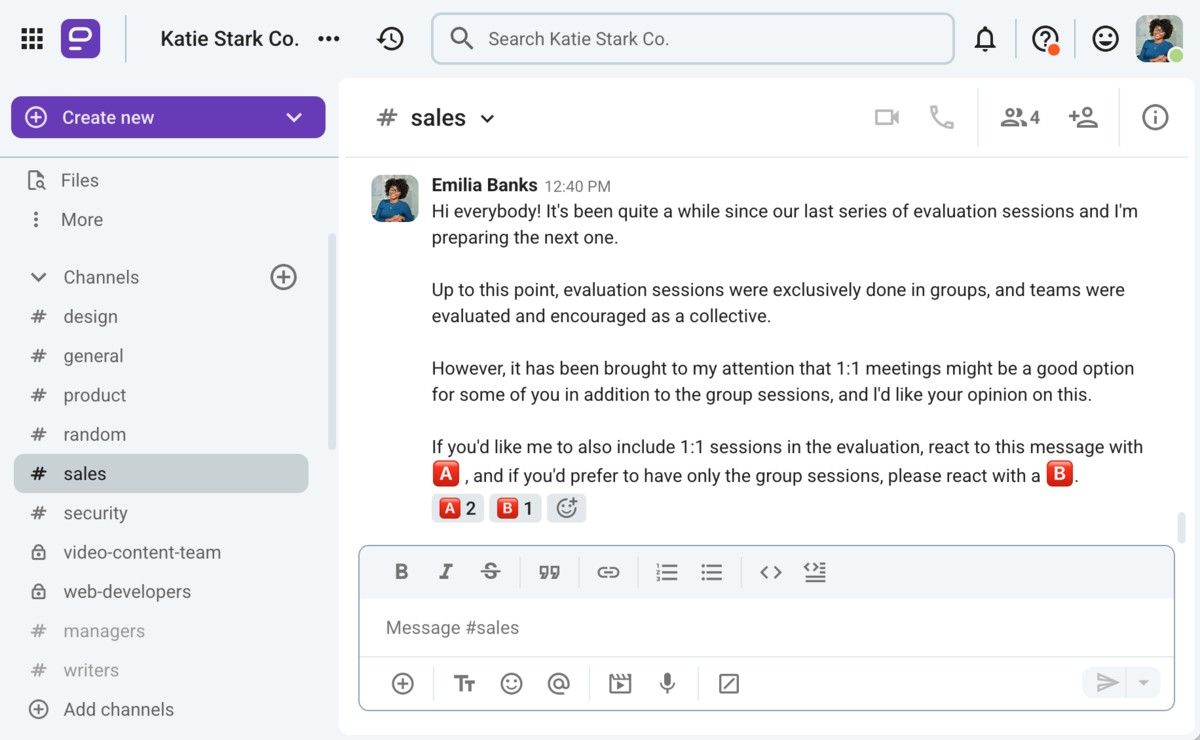
Ao receber comentário, lembre-se de não apressar a interação, diz Dawid Wiacek, mentor de carreira executiva e comunicação:

“No cenário empresarial atual, a velocidade costuma ser uma vantagem competitiva, mas para uma comunicação bem-sucedida, um dos segredos é desacelerar. Para garantir que a outra pessoa tenha absorvido sua mensagem corretamente, é útil pedir que ela a resuma com suas próprias palavras.”
Wiacek também ofereceu algumas dicas sobre como fazer isso corretamente:

“Você pode perguntar:
- O que repercutiu na mensagem e o que não repercutiu
- O que eles perceberam como central e o que foi secundário
- O que foi valioso e talvez surpreendente
O objetivo é conectar-se com o destinatário e garantir que a mensagem original tenha sido traduzida corretamente e não se perdido na tradução.”
Dê feedback de forma mais eficaz com o Pumble
Dica 4: Considere o contexto cultural
Embora possa ser estressante, dar feedback aos colegas é essencial em praticamente qualquer trabalho.
O ideal é que o façamos de forma construtiva e motivadora, mas nem sempre é o caso. Mesmo sem a intenção de ofender alguém, uma situação pode surgir como resultado de diferenças culturais, relacionadas ao trabalho ou outras.
Tomamos a seguinte troca como exemplo.
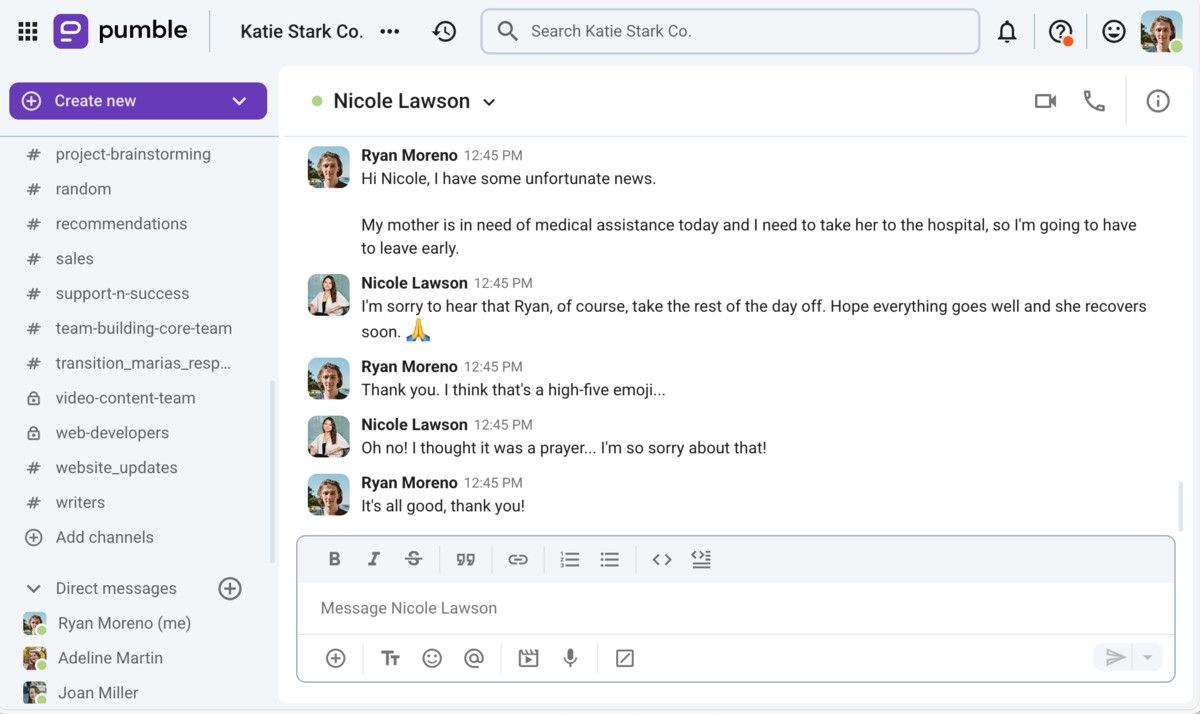
Nicole (dos EUA) envia seus melhores votos a Ryan, que trabalha no Japão há 6 anos. Um pequeno mal-entendido surge porque Nicole presumiu que Ryan interpretaria o significado de um emoji da mesma forma que ela.
Esse tipo de erro às vezes é fácil de lidar; neste caso, Nicole e Ryan conseguiram resolver as coisas rapidamente e seguir em frente.
No entanto, todos os funcionários devem ser estrategicamente incentivados a se adaptar e a estar cientes de possíveis diferenças para evitar qualquer tensão ou discussões sérias.
Joanna Staniszewska destacou a importância da inteligência cultural e da sensibilidade:

“A comunicação ocorre em vários ambientes. Destaca a importância da consciência e da sensibilidade cultural. “Isso incentiva os indivíduos a adaptarem seus estilos de comunicação para ressoarem com as normas culturais e expectativas do público.”
Dica 5: Pesquise diferentes estilos de comunicação
Entender seu estilo de comunicação preferido e adaptá-lo ao dos seus colegas pode fazer uma grande diferença na colaboração em equipe.
Quando alguém se fecha repentinamente durante o processo de comunicação, pode não ser por causa de algo que você disse ou fez intencionalmente.
Por exemplo, embora você pensasse que estava defendendo sua ideia com firmeza, seu colega pode ter sentido que você estava atacando sutilmente a dele.
O principal problema: a diferença entre seus estilos de comunicação.
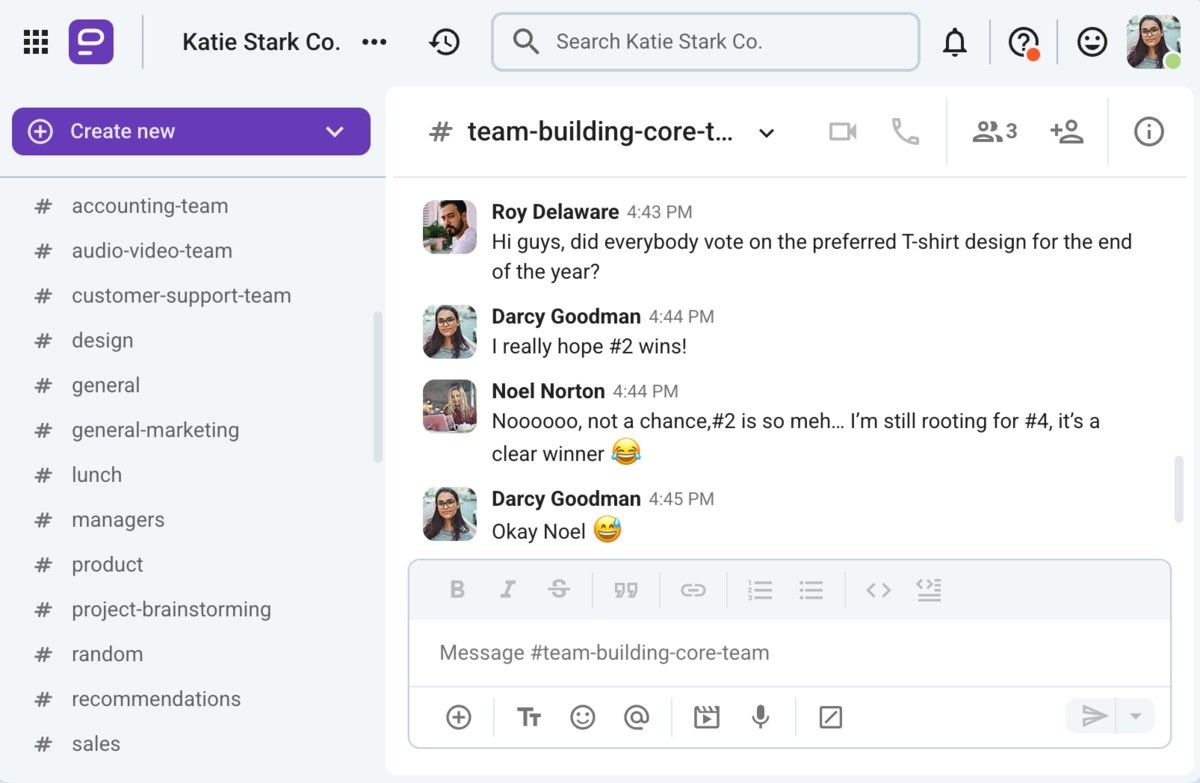
Conecte-se com sua equipe no Pumble
Se você se encontra frequentemente em situações semelhantes, uma combinação de autoconsciência e social pode ajudá-lo a fortalecer sua inteligência emocional. Gradualmente, trabalhar nisso ajudará você a ganhar mais controle sobre como fala e age no trabalho.
Se precisar de mais orientação, outra estratégia seria inscrever-se em um curso de desenvolvimento profissional que possa ajudá-lo a se tornar um comunicador mais transparente e flexível.
🎓 Dica profissional do Pumble
Para obter mais informações sobre os diferentes estilos de comunicação, além de ser mais flexível na comunicação empresarial, confira este guia:
Dica 6: Leve em consideração as mudanças demográficas da força de trabalho
Como líder de equipe, você precisa descobrir como se conectar e colaborar com colegas de diferentes gerações e inspirar outros a fazerem o mesmo.
Como todos temos hábitos e preferências específicos, a diferença de gerações também pode fazer com que nosso comportamento seja diferente do de nossos colegas, sejam eles mais velhos ou mais jovens.
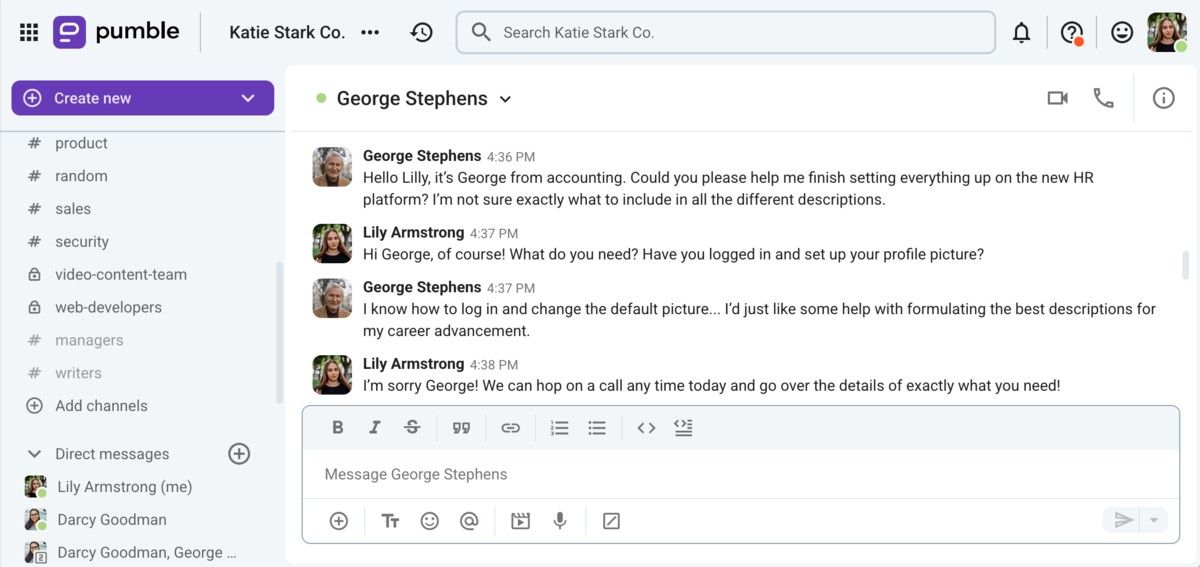
Superar estas diferenças e parar de recorrer a estereótipos é o caminho a seguir para criar um ambiente inclusivo e bem conectado.
Seja completamente honesto sobre suas formas preferidas de comunicação e respeite os limites dos membros da sua equipe. Assim que perceberem esses esforços, eles se sentirão mais confortáveis para pedir ajuda ou se comunicar sobre uma tarefa de trabalho.
🎓 Dica profissional do Pumble
Interessado em saber mais sobre como melhorar a comunicação intergeracional em sua equipe ou empresa? Confira:
Por que o processo de comunicação é importante?
Através da forma como nos comunicamos, aprendemos não apenas como progredir na vida, mas também como formar relacionamentos estáveis.
Compreendendo o processo de comunicação:
- Ele afeta a maneira como vemos os outros e a nós mesmos
- Afeta a maneira como aprendemos
- Nos ajuda a fazer o nosso melhor trabalho
Quando você trabalha em equipe, sua forma de comunicação pode projetar uma imagem positiva tanto de você quanto de seus colegas. Quando seu estilo de comunicação reflete profissionalismo e respeito, chegar a acordos e negociar acordos se torna muito menos complicado.
Sem falar que, aliada a uma excelente ética de trabalho, a comunicação forte é uma grande vantagem na hora de avançar para uma posição de liderança. E, se você decidir mudar de empresa, habilidades de comunicação oral e escrita melhorarão significativamente suas perspectivas de emprego.
🎓 Dica profissional do Pumble
Se você cometer um erro ao ingressar em uma nova equipe, uma boa comunicação pode ajudá-lo a resolver quaisquer problemas persistentes. No entanto, para evitar completamente essas situações embaraçosas e aprender como causar uma boa primeira impressão, confira a seguinte postagem de blog:
Use o Pumble para Facilitar o Processo de Comunicação da Sua Equipe
Compreender o processo de comunicação e sua importância lhe dará uma vantagem inicial para alcançar o próximo nível no desenvolvimento da sua equipe.
Nesse contexto, integrar uma ferramenta projetada para simplificar a comunicação ajuda a otimizar seus canais de comunicação e a promover conexões significativas no espaço de trabalho.
Para essa vaga, o Pumble — é a solução ideal: o aplicativo completo de comunicação em equipe.
O Pumble simplifica a comunicação para equipes híbridas, remotas e presenciais, oferecendo recursos que agilizam a comunicação escrita e verbal da sua equipe, como:
- Canais – espaços dedicados para simplificar a comunicação por meio de notificações rápidas para grupos de pessoas,
- Threads – respostas a mensagens para navegar pelos tópicos dos canais (ótimo para feedback)
- Mensagens Diretas – para conversas individuais e referência futura
- Videoconferência – para conversas presenciais e construção de confiança por meio de feedback visual
- Gravação de Reuniões – para revisar conversas importantes da equipe e eliminar vieses inconscientes
- Histórico de mensagens Ilimitado – para acessar mensagens desde o primeiro dia de criação do espaço de trabalho e agilizar o processo de comunicação
- Compartilhamento de arquivos com Busca Global – para encontrar documentos importantes compartilhados pela sua equipe desde o primeiro dia e agilizar a distribuição de informações.
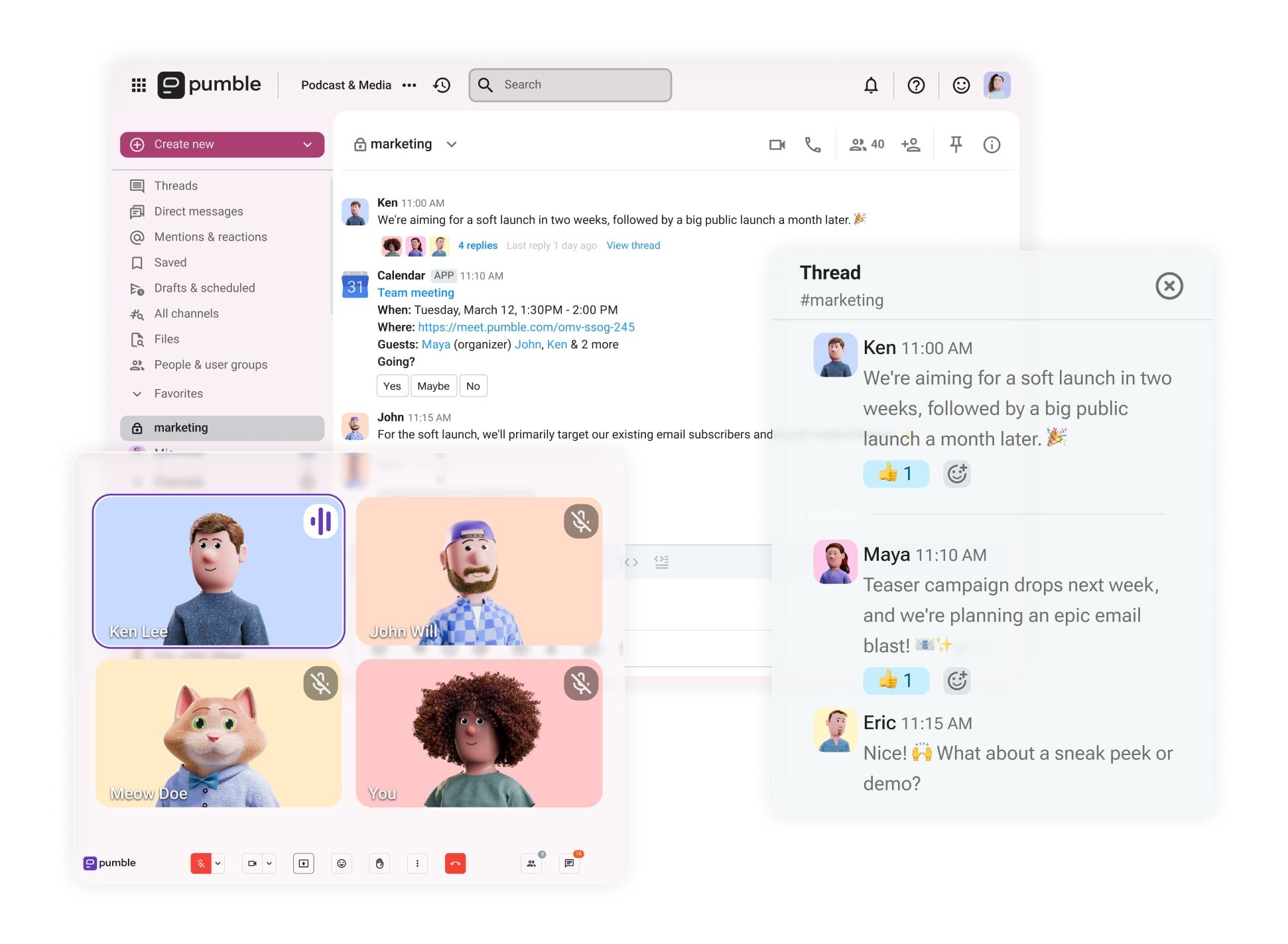
Com sua interface intuitiva e recursos de mensagens em tempo real, o Pumble aborda os principais desafios de comunicação. Problemas de comunicação, como sobrecarga de informações e canais isolados. O Pumble substitui o e-mail como um hub de comunicação abrangente e altamente personalizável (ajudando a evitar a sobrecarga de informações) e permite que você conecte todos por meio de canais relevantes (reduzindo a possibilidade de isolamento).
Ao integrar o Pumble ao seu processo de comunicação, você pode:
- Promover a transparência
- Otimizar os fluxos de trabalho da equipe
- Melhorar a coesão da equipe
Simplifique o processo de comunicação da sua equipe hoje mesmo.
Experimente o Pumble da CAKE.com
Como avaliamos esta publicação: Nossos escritores e editores monitoram as postagens e as atualizam quando novas informações ficam disponíveis, para mantê-las atualizadas e relevantes.
